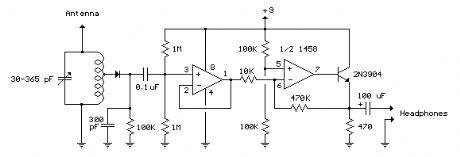The diode, resistor and capacitor form the demodulator. The resistor discharges the capacitor charged by the diode hence (in conjunction with the 300pF cap) it sets a high frequency audio cutoff of \$f_m = \frac{1}{2\pi R C }\$ or about 5.5kHz. It filters out virtually all of the carrier frequency since the carrier frequency of AM radio is >> 5.5kHz.
The output transistor is supposed to boost the op-amp output a bit- but with that 470 ohm resistor(!) I don't think it does much useful. The op-amp alone is capable of driving a modern sensitive headphone well enough.
Eg. a typical in-ear headphone has a sensitivity of 100-120dB SPL/mW (that's lots of volume) with an 18 ohm impedance. That means ~7mA is plenty, and the op-amp alone is fine since it can typically drive 20mA or so.

